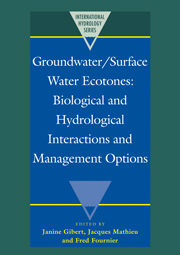Book contents
- Frontmatter
- Contents
- List of authors
- Preface
- I INTRODUCTION
- II FUNCTION OF GROUNDWATER / SURFACE WATER INTERFACES
- III MALFUNCTION OF GROUNDWATER / SURFACE WATER INTERFACES: CAUSES AND METHODS OF EVALUATION
- IV MANAGEMENT AND RESTORATION OF GROUNDWATER / SURFACE WATER INTERFACES
- 24 Ecotones and problems of their management in irrigation regions
- 25 Hydrochemistry and ecohydrology of the transition area of the Netherlands Delta and the Brabantse Wal
- 26 Cautious reforestation of a wetland after clearfelling
- 27 Responses of riparian ecosystems to dewatering of the Aral Sea in the vicinity of the Tedgen and Murgab rivers
- 28 Water regime management of desertificated ecotone systems in the Amudarya delta (Aral Sea basin)
- V CONCLUSION
- ANNEX
27 - Responses of riparian ecosystems to dewatering of the Aral Sea in the vicinity of the Tedgen and Murgab rivers
Published online by Cambridge University Press: 07 September 2010
- Frontmatter
- Contents
- List of authors
- Preface
- I INTRODUCTION
- II FUNCTION OF GROUNDWATER / SURFACE WATER INTERFACES
- III MALFUNCTION OF GROUNDWATER / SURFACE WATER INTERFACES: CAUSES AND METHODS OF EVALUATION
- IV MANAGEMENT AND RESTORATION OF GROUNDWATER / SURFACE WATER INTERFACES
- 24 Ecotones and problems of their management in irrigation regions
- 25 Hydrochemistry and ecohydrology of the transition area of the Netherlands Delta and the Brabantse Wal
- 26 Cautious reforestation of a wetland after clearfelling
- 27 Responses of riparian ecosystems to dewatering of the Aral Sea in the vicinity of the Tedgen and Murgab rivers
- 28 Water regime management of desertificated ecotone systems in the Amudarya delta (Aral Sea basin)
- V CONCLUSION
- ANNEX
Summary
ABSTRACT Nowadays the ecological sustainability of water bodies is uncertain because of anthropogenic acceleration of environmental change. The Tedgen and Murgab oases in Central Asia are zones of threshold ecological tension because they are near to the zone of Aral ecological crisis. Riparian ecosystems of the rivers Tedgen and Murgab serve as indicators of this tension. The waters of Tedgen and Murgab have high mineralization, especially sulfate, and are polluted by phenol and pesticides. The riparian ecotone reflects impacts of pollution: 51% of riparian ecosystems of these rivers have semisalted soils, 10% – heavy and very heavy salted soils and 38% – nonsalted or little salted soils. Also 30% of all salted soils have the sulphate type of salinization. In the future riparian ecotone may be expected to sequester various pollutants. Parameters for monitoring are: 1) biodiversity of riparian phytocoenoses; 2) presense and amount of pollutants; 3) direction and character of matter flows through ecotones; 4) character of processes in ecotones.
INTRODUCTION
Catastrophic consequences of irrigational activity have occurred in the Aral region during the last 30 years. This sea lost 900 cubic kilometres of water or 16 years of runoff by river inflow. Its level dropped by 15 meters, water surface shrank by 45% and water volume decreased by 65%. Its salinity increased by three times. The sea is now composed of three basins, rather than one. About 70 million tons of salted dust are carried away from the dried bottom of the sea annually. The dust reaches distances of 300–500 kilometres from the sea.
- Type
- Chapter
- Information
- Groundwater/Surface Water EcotonesBiological and Hydrological Interactions and Management Options, pp. 208 - 211Publisher: Cambridge University PressPrint publication year: 1997

